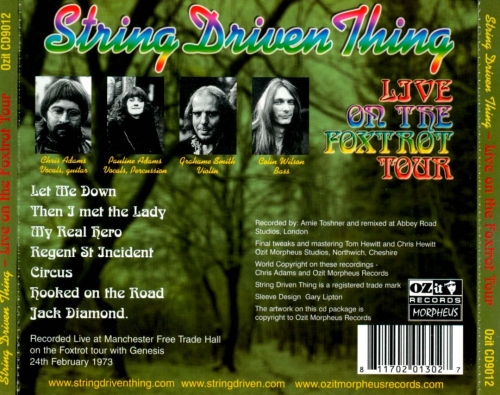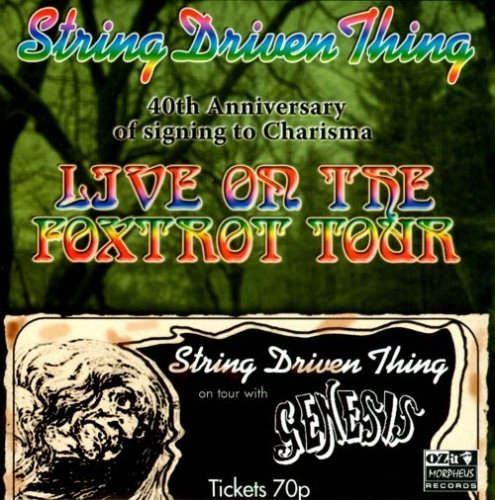
String Driven Thing - Live On The Foxtrot Tour (Reissue) (1973/2012)
BAND/ARTIST: String Driven Thing
- Title: Live On The Foxtrot Tour
- Year Of Release: 1973/2012
- Label: OZIT RECORDS UK
- Genre: Folk Rock, Prog Rock
- Quality: Flac (image, .cue, log)
- Total Time: 48:07
- Total Size: 337 Mb (scans)
- WebSite: Album Preview

Tracklist:
1. Let Me Down - 6:04
2. Then I Met The Lady - 6:21
3. My Real Hero - 4:13
4. Regent St Incident - 4:27
5. Circus - 7:57
6. Hooked On The Road - 4:49
7. Jack Diamond - 14:13
Grahame Smith - Violin
Pauline Adams - Vocals, Percussion
Colin Wilson - Bass
Chris Adams - Vocals, Guitar
One of the finest bands signed to the Charisma label during its early-'70s heyday, Scotland's String Driven Thing originally formed as a trio in 1969, led by the husband-and-wife team of Chris and Pauline Adams, plus percussionist John Mannion. Locally popular at the tail end of the 1960s, the band faded from view shortly after releasing a self-titled debut album in 1970. They continued playing, however, with the lineup expanding to include bassist Colin Wilson
In early 1972, Chris Adams journeyed to London, hoping to interest the Strawbs' management with a three-song demo. Finding himself with some free time, he was flicking through the record labels section of the Yellow Pages when he spotted Stratton Smith Enterprises. He called and found himself in conversation with the head of Charisma chief Tony Stratton Smith's publishing company, Mooncrest Music. Within a week, Stratton Smith himself was in Glasgow, for a String Driven Thing showcase at the Burns' Howff pub; a week after that, the band signed with his label.
Shedding Mannion around the same time, the group returned to Glasgow with a princely retainer of 20 pounds per week, to rehearse. A month later, they went back south for their first ever live shows as a "signed" band: a community hall in the town of Tunbridge Wells, where Strat had his country retreat, and the 1972 Reading Festival. It was an audacious entry, but it worked and the group quickly set to work on its first Charisma album, to be titled -- like its independent predecessor -- String Driven Thing.
Recorded in two weeks in August 1972 with producer Shel Talmy, the album landed rave reviews across the music press, with Melody Maker in particular leaping onto the group's side. (Amusingly, it later transpired that the album's distinctive gatefold sleeve, designed by Po of Hipgnosis, cost more than the actual recording sessions!)
Honky Château The band continued pushing forward. Visiting France, they stopped by the renowned Chateau D'Heuroville studios (the Honky Chateau of Elton John fame), where they were filmed recording some songs with a French producer, who later claimed he'd done a better job than Shel Talmy ("he had a point," mused Adams); December 1972, meanwhile, saw the band fly to New York to support Genesis at that band's first ever American show, at the Philharmonic Hall.
String Driven Thing's rise ought to have been inexorable. Their latest single, "Circus," was making waves on both sides of the Atlantic, and plans were afoot for the group to join Genesis on their own latest tours of both Britain and the U.S. Unfortunately, the beginning of 1973 saw Chris Adams hospitalized with a collapsed lung, an event that was to have a serious impact on String Driven Thing's future.
The Machine That Cried That experience, and the nightmare of the next week's worth of agonizing recuperation was to form the inspiration for much of The Machine That Cried, String Driven Thing's next album. However, although the band did make it onto the British dates, the American shows never happened; instead, the band found itself shunting up and down the British highway system, playing small clubs and universities, and breaking in the new material.
The group's management at this time was being handled by Charisma's own in-house team, a less than satisfactory arrangement, but one that Stratton Smith seemed unwilling to change. Indeed, when Adams approached him to speak of the group's "total lack of confidence" in the setup, he simply "hummed and hawed and did nothing." Neither was that the end of the group's travails. In conversation with another label staffer one day, Adams mentioned that the band was considering adding a drummer to the lineup. A few days later, Stratton Smith showed up at a concert in Oxford, and instead offered them a keyboard player, Robert John Godfrey. He survived a week of rehearsals, but just one show, at the London Roundhouse, before the band declared him unsuitable and brought in a drummer (fellow Glaswegian Billy Fairley) after all. Godfrey went on to his own solo career at Charisma.
In this form, String Driven Thing returned to the studio to record The Machine That Cried, alongside what remains their best-known number, the single "It's a Game." The LP has since been acclaimed not merely String Driven Thing's masterpiece, but one of the finest progressive rock albums of the entire era -- its CD reissue on the British Ozit label was widely heralded as among the most intelligent re-releases of recent years, and the excitement that greeted the re-formed String Driven Thing's return to action hailed almost wholly from memories of this marvelous album. At the time, however, all seemed doom-laden. "It's a Game," although it received plenty of British airplay, went nowhere (although a hit Bay City Rollers cover later went some way toward making amends); The Machine That Cried simply died and, by the end of the year, String Driven Thing looked to have followed it, as both the Adams and Chris Wilson walked out. Stratton Smith alone was left to carry the flag, rebuilding the group around himself and newfound vocalist Kim Beacon, and soldiering on until 1975. The two albums that followed both have their place in the prog rock pantheon, but the magic had gone from the band.
It returned in the late '90s, as the Adams returned to the helm, overseeing both reissues of the band's original albums, and the preparation of new material and concerts.
In early 1972, Chris Adams journeyed to London, hoping to interest the Strawbs' management with a three-song demo. Finding himself with some free time, he was flicking through the record labels section of the Yellow Pages when he spotted Stratton Smith Enterprises. He called and found himself in conversation with the head of Charisma chief Tony Stratton Smith's publishing company, Mooncrest Music. Within a week, Stratton Smith himself was in Glasgow, for a String Driven Thing showcase at the Burns' Howff pub; a week after that, the band signed with his label.
Shedding Mannion around the same time, the group returned to Glasgow with a princely retainer of 20 pounds per week, to rehearse. A month later, they went back south for their first ever live shows as a "signed" band: a community hall in the town of Tunbridge Wells, where Strat had his country retreat, and the 1972 Reading Festival. It was an audacious entry, but it worked and the group quickly set to work on its first Charisma album, to be titled -- like its independent predecessor -- String Driven Thing.
Recorded in two weeks in August 1972 with producer Shel Talmy, the album landed rave reviews across the music press, with Melody Maker in particular leaping onto the group's side. (Amusingly, it later transpired that the album's distinctive gatefold sleeve, designed by Po of Hipgnosis, cost more than the actual recording sessions!)
Honky Château The band continued pushing forward. Visiting France, they stopped by the renowned Chateau D'Heuroville studios (the Honky Chateau of Elton John fame), where they were filmed recording some songs with a French producer, who later claimed he'd done a better job than Shel Talmy ("he had a point," mused Adams); December 1972, meanwhile, saw the band fly to New York to support Genesis at that band's first ever American show, at the Philharmonic Hall.
String Driven Thing's rise ought to have been inexorable. Their latest single, "Circus," was making waves on both sides of the Atlantic, and plans were afoot for the group to join Genesis on their own latest tours of both Britain and the U.S. Unfortunately, the beginning of 1973 saw Chris Adams hospitalized with a collapsed lung, an event that was to have a serious impact on String Driven Thing's future.
The Machine That Cried That experience, and the nightmare of the next week's worth of agonizing recuperation was to form the inspiration for much of The Machine That Cried, String Driven Thing's next album. However, although the band did make it onto the British dates, the American shows never happened; instead, the band found itself shunting up and down the British highway system, playing small clubs and universities, and breaking in the new material.
The group's management at this time was being handled by Charisma's own in-house team, a less than satisfactory arrangement, but one that Stratton Smith seemed unwilling to change. Indeed, when Adams approached him to speak of the group's "total lack of confidence" in the setup, he simply "hummed and hawed and did nothing." Neither was that the end of the group's travails. In conversation with another label staffer one day, Adams mentioned that the band was considering adding a drummer to the lineup. A few days later, Stratton Smith showed up at a concert in Oxford, and instead offered them a keyboard player, Robert John Godfrey. He survived a week of rehearsals, but just one show, at the London Roundhouse, before the band declared him unsuitable and brought in a drummer (fellow Glaswegian Billy Fairley) after all. Godfrey went on to his own solo career at Charisma.
In this form, String Driven Thing returned to the studio to record The Machine That Cried, alongside what remains their best-known number, the single "It's a Game." The LP has since been acclaimed not merely String Driven Thing's masterpiece, but one of the finest progressive rock albums of the entire era -- its CD reissue on the British Ozit label was widely heralded as among the most intelligent re-releases of recent years, and the excitement that greeted the re-formed String Driven Thing's return to action hailed almost wholly from memories of this marvelous album. At the time, however, all seemed doom-laden. "It's a Game," although it received plenty of British airplay, went nowhere (although a hit Bay City Rollers cover later went some way toward making amends); The Machine That Cried simply died and, by the end of the year, String Driven Thing looked to have followed it, as both the Adams and Chris Wilson walked out. Stratton Smith alone was left to carry the flag, rebuilding the group around himself and newfound vocalist Kim Beacon, and soldiering on until 1975. The two albums that followed both have their place in the prog rock pantheon, but the magic had gone from the band.
It returned in the late '90s, as the Adams returned to the helm, overseeing both reissues of the band's original albums, and the preparation of new material and concerts.
Oldies | Rock | FLAC / APE
As a ISRA.CLOUD's PREMIUM member you will have the following benefits:
- Unlimited high speed downloads
- Download directly without waiting time
- Unlimited parallel downloads
- Support for download accelerators
- No advertising
- Resume broken downloads


